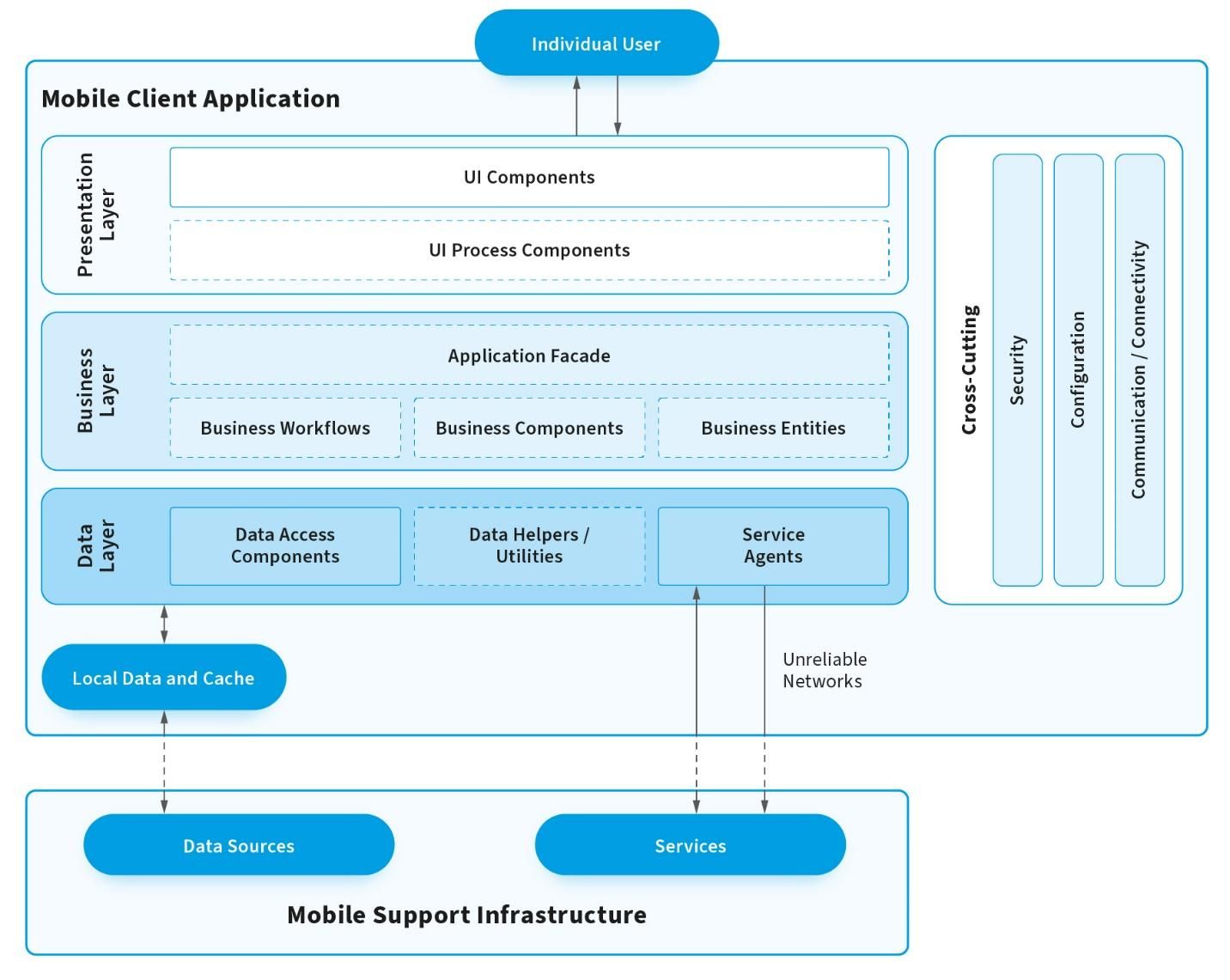Mobile App Development Architecture Guide for 2023 - What is it, why it’s important, and what best practices to consider
Written by Luis Paradela|Posted on April 18, 2023

Mobile app architecture is a crucial aspect of mobile app development that outlines the underlying structure of an app, including its components, modules, and their interactions. It defines how the app will be developed, deployed, and maintained. In this article, we will discuss the best practices for mobile app architecture in 2023, what a mobile app architecture diagram is, how to know if your app has a good architecture, elements to consider before developing your mobile app architecture, and steps to choose the right mobile app architecture for you.
Mobile app architecture refers to the underlying structure of a mobile application that outlines its components, modules, and their interactions. It defines how the application will be developed, deployed, and maintained. Mobile app architecture is critical to the success of any app, as it influences its performance, scalability, security, and user experience.
The 3 Layers of Mobile App Architecture
Mobile app architecture is typically divided into three layers:
- Presentation Layer: This layer is responsible for the user interface (UI) and how the app is presented to the user. It includes the app's visual elements, such as buttons, text boxes, and images, and how they are arranged on the screen. The presentation layer also handles user input and interaction with the app, such as tapping buttons or scrolling through content.
- Business Layer: This layer handles the business logic of the app, including data processing, storage, and retrieval. The app's core functionality consists of user authentication, data validation, and data processing. The business layer interacts with the presentation layer to receive user input and provide output back to the user.
- Data Layer: This layer deals with storing and retrieving data, such as databases and file systems. It includes the mechanisms for storing and accessing data, such as APIs, data models, and data storage architectures. The data layer interacts with the business layer to provide data for processing and storage.
The Importance of Mobile App Architecture
Mobile app architecture is crucial for developing high-quality apps that meet user expectations. It helps create an efficient, flexible, and scalable app that can be easily maintained and upgraded. A well-defined architecture ensures the app is secure, reliable, and user-friendly.
Benefits of Creating a Clearly Defined Mobile App Architecture
- Stability: A clearly defined mobile app architecture ensures that the app is stable and performs consistently across different devices and platforms. It minimizes the risk of crashes, errors, and unexpected behavior by ensuring that the app's components are well-defined and interact smoothly with each other.
- Process Efficiency/Flexible and Agile Development Methods: A well-defined architecture enables flexible and agile development, making incorporating changes and new features into the app easier. It streamlines the development process by providing a clear roadmap of the app's components, which reduces the risk of errors, redundancies, and delays.
- Easier to Work with: A clear mobile app architecture makes it easier for developers to work with the app's code and modules, reducing the time and effort required to develop and maintain the app. It enables developers to focus on specific components or modules of the app without worrying about the overall architecture and functionality.
- Makes for Easier Future Maintenance: A well-defined mobile app architecture facilitates future maintenance and upgrades by providing a clear roadmap of the app's structure and components. It makes it easier to identify potential issues or areas for improvement and make changes without disrupting the app's functionality.
To ensure the success of your mobile app in 2023, it is important to follow some best practices for mobile app architecture:
- Use a Modular Approach: A modular approach to designing the app's architecture makes it easier to maintain, update and scale the app. A modular approach involves dividing the app into smaller modules, each responsible for a specific function. This approach makes it easier to fix bugs, update features, and add new functionalities without affecting the entire app.
- Leverage Cloud Services: Cloud services can help to improve app performance and scalability. They provide a scalable and flexible infrastructure that can handle large amounts of data and users. Cloud services also help to reduce the app's operational costs by eliminating the need for maintaining on-premises infrastructure.
- Adopt a Responsive Design: A responsive design ensures that the app looks and performs well across different devices, platforms, and screen sizes. It involves designing the app's UI to adapt to the user's device, ensuring a consistent and optimized user experience.
- Prioritize Security: Security should be a top priority in mobile app architecture. It is important to incorporate robust security mechanisms into the app's architecture to prevent data breaches and protect user privacy.
What is a Mobile App Architecture Diagram?
A mobile app architecture diagram is a visual representation of the app's underlying structure and components. It illustrates how the app's different layers, modules, and components interact with each other to provide its functionality. Here is an example of a mobile app architecture diagram:

A good mobile app architecture should exhibit the following characteristics:
- Efficiency: The app should perform well, even under heavy usage and with limited resources. A well-architected app should be optimized to ensure that it uses minimum resources to execute tasks, ensuring smooth performance.
- Flexibility: The app should be adaptable to changes in user requirements and business needs. This involves designing the app's architecture in a way that makes it easy to incorporate new features and functionalities without affecting the app's stability.
- Extensibility: The app should be designed to incorporate new features and modules in the future. The architecture should be designed with a modular approach that makes it easy to add new functionalities, update existing ones, or replace them with new ones
- Scalability: The app should be scalable and able to handle increasing user demands and data volumes. The architecture should be designed to handle spikes in user activity without affecting the app's performance or stability.
- Testability: The app should be easily testable to ensure that it performs as expected. The architecture should be designed in a way that makes it easy to test each component or module individually, ensuring that the app works as intended.
- Understandability: The app's architecture should be easy to understand, even for non-technical stakeholders. A well-designed architecture should be documented with clear explanations of each component and module, making it easy for stakeholders to understand how the app works.
Following are some of the elements that you should consider before developing your mobile app architecture:
- Dimensions/Device types: One of the crucial aspects to consider while developing a mobile app architecture is the dimensions or screen sizes of the device. It is important to ensure that the app looks and works great on different device sizes, such as smartphones, tablets, or wearable devices.
- Bandwidth scenarios: The speed and reliability of network connections vary depending on location and bandwidth. Therefore, it is essential to design an architecture that takes into account different bandwidth scenarios, such as low network connectivity, no connectivity, or intermittent connectivity, to ensure optimal user experience.
- Defining User Interface (UI): The UI is the first interaction point between the user and the app. It is essential to create an intuitive and user-friendly interface that allows users to navigate easily, find relevant information, and perform actions with ease.
- Navigation Method: The navigation method defines how users will navigate through the app. It is important to choose the appropriate navigation method based on the app's complexity and content, to ensure easy and intuitive user interaction.
By considering these elements during the design process, the mobile app architecture can be optimized to deliver a smooth, efficient, and effective user experience.
Choosing the right mobile app architecture for your project can be a complex and challenging task. However, by following these five steps, you can increase your chances of making the right decision:
- Before you start developing your mobile app, it's crucial to understand who your target audience is and the problem or challenge you are trying to solve. By talking to your potential customers and gathering feedback, you can better understand what they're looking for in a mobile app and what features are most important to them. This information can help you select an architecture that's best suited to your customers' needs.
- Developing a test app is an excellent way to test different mobile app architectures before committing to a specific one. With a test app, you can quickly evaluate different architectures and see which one works best for your project's requirements.
- Once you've selected an architecture, it's time to focus on polishing the key functionalities of your mobile app. By paying close attention to user experience and ensuring that your app's critical features work flawlessly, you can increase your app's chances of success.
- Developing a mobile app requires a talented team of developers and designers. Before you start, it's essential to ensure that your team is ready to tackle the project's technical challenges. Make sure your team has the necessary skills and experience to work with the selected architecture.
- Choosing the right mobile app architecture is not just about technical considerations. It's also about the budget. By selecting an architecture that's well-suited to your project's requirements, you can optimize your budget and ensure that you're not overspending on features you don't need. Consider the cost of development, maintenance, and future upgrades when making your decision.
In summary, a good mobile app architecture should be efficient, flexible, extensible, scalable, testable, and understandable. By following best practices and designing an architecture that exhibits these characteristics, developers can create high-quality mobile apps that meet user expectations and business requirements. As an experienced mobile app development company, AccelOne’s developers create innovative apps across multiple platforms and technologies, offering application development services for iOS, Android, Xamarin, and more.

Luis Paradela
Chief Development Officer
Co-Founder
Buenos Aires
View profile